Yellow flowering shrubs when grown at the right place and in the right manner in a front yard or backyard they tend to brighten the whole place, creating visual interest and enhancing the overall beauty of the yard.
Yellow flowering shrubs are believed by many people especially in Asia and Europe to symbolize wealth, happiness and prosperity. They are also excellent attractants of pollinators like bees, butterflies and hummingbirds to a home garden.
From small, compact varieties to tall, sprawling ones, yellow flowering shrubs come in different sizes and appeal. It is therefore easy to find the perfect one for your outdoor space.
Here are some of the best yellow flowering shrubs for your garden. The article will look at their unique characteristics and growing requirements.
List of yellow flowering shrubs
- Forsythia
- Potentilla
- Witch Hazel
- Golden Chain Tree
- Yellow Twig Dogwood
- Japanese kerria
- Mahonia
- Carolina Jessamine
- Yellow Azalea
- Yellow Roses
- Austrian Briar
- Yellow Elder
Facts About Yellow Flowering Shrubs
- Yellow flowering shrubs are often used in feng shui to attract positive energy and good fortune. They are believed to symbolize wealth, happiness, and prosperity.
- They can vary in size from small varieties to tall, sprawling shrubs. They can be used in garden design to create contrast with other plants and bring balance to a landscape.
- Some shrubs such as Potentilla and Witch Hazel, have medicinal properties and are used in traditional medicine to treat a range of ailments.
- Some like Golden Chain Tree and Carolina Jessamine, are good in attracting pollinators like bees, butterflies and hummingbirds to a home garden.
- Many yellow flowering shrubs are deciduous which means they lose their leaves in the fall and go dormant during the winter. Some such as Mahonia and Yellow Azalea, are evergreen and provide year-round interest.
Forsythia
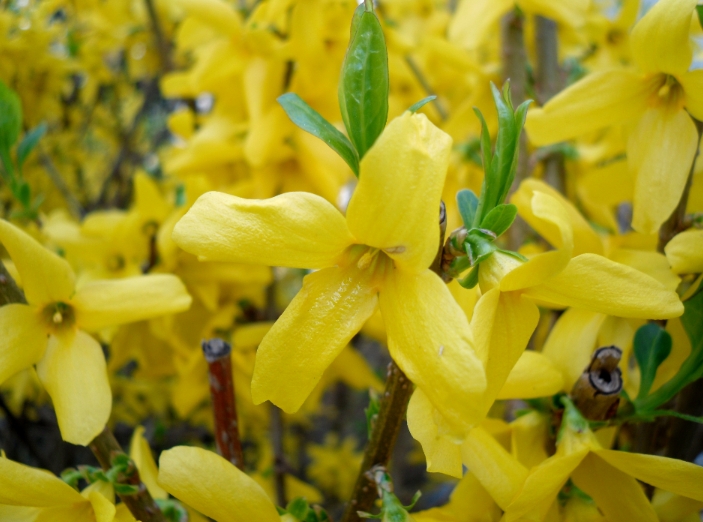
Forsythia is a genus of flowering plants in the olive family. Forsythia is named after William Forsyth, a Scottish botanist who was director of the Royal Horticultural Society in London in the late 1700s.
Forsythia grows up to 10 feet tall and 12 feet wide. It has an upright habit with many slender branches that arch slightly at the tips, creating fountain-like appearance.
Forsythia is a deciduous shrub that can be grown for its early, prolific, yellow flowers that appear in late winter or early spring. The leaves are simple, lance-shaped and bright green.
The flowers are bell-shaped, with four petals and a tubular center, and appear in clusters along the length of the branches before the leaves emerge. The flowers are a bright, sunny yellow color and can cover the entire shrub.
In the yard, plant it near other plants with contrasting foliage or flowers. You still can grow it in containers and use it for small spaces, patios or balconies. This allows you to enjoy its beauty even if you don’t have a traditional garden space.
Also Read: Different Types of Evergreen Shrubs To Add Interest To Your Garden
Data And Facts
| Scientific Name | Forsythia ssp |
| Family | Olive family |
| Number of Species | 11 |
| Type | Deciduous |
| USDA Zone | 5 to 8 |
| Size | 12 feet tall and 12 feet wide |
| Native Area | Eastern Europe and Asia |
| Growth Rate | Fast |
| Form | Mounded, round or upright |
Potentilla
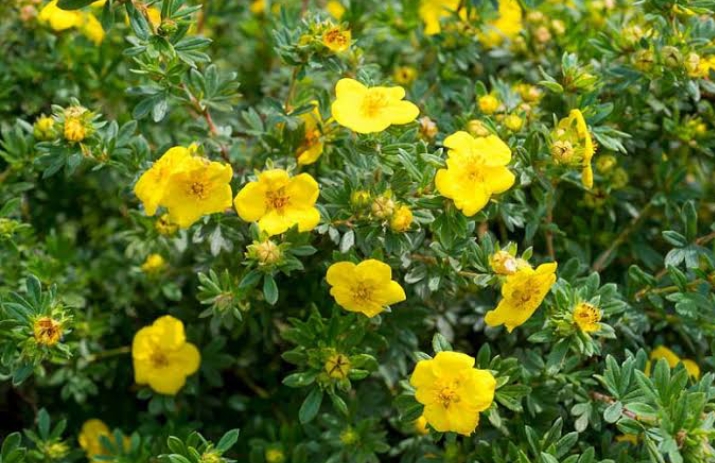
Potentilla, also known as cinquefoil is a small to medium-sized shrub, growing to about 2 to 4 feet tall. Potentilla has woody stems that are covered in small, green leaves. In colder climates, the leaves may turn yellow or reddish in the fall before dropping off.
The leaves are often one of the first signs of growth in the spring, emerging from the woody stems as the weather warms up. In the spring yellow flowers emerge. The petals of these flowers are rounded in shape, with a crinkled or ruffled appearance.
Potentilla flowers are long-lasting, with blooms lasting for several weeks to several months. This is a hardy shrub that can adapt survive in low-maintenance landscapes with minimal watering and fertilization.
Potentilla can be used to create low hedges or as part of a mixed planting with other shrubs and perennials. Its small size and long blooming period, make it a good choice for layering in front of taller plants. This shrub still works well on slopy yards.
Facts And Data
| Scientific Name | Potentilla ssp |
| Family | rose family, Rosaceae. |
| Number of Species | over 500 species |
| Type | Deciduous |
| USDA Zone | 2-7 |
| Size | 2 to 4 feet tall |
| Native Area | Europe and Asia |
| Growth Rate | Moderate |
| Form | Mounded, round or upright |
Witch Hazel
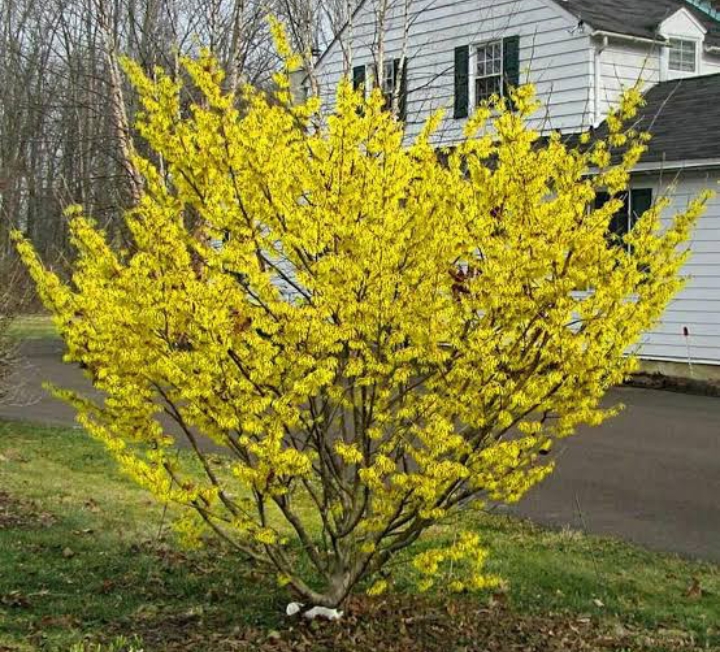
Witch Hazel is also another yellow flowering shrub that can add structure and interest to the yards. It is a slow-growing shrub. It can reach heights of up to 15 feet, but more often grows under 10 feet tall with a rounded or irregular shape. It is a long-lived shrub, with some specimens living for over 100 years.
The leaves of Witch Hazel are simple and dark green in color. They turn yellow or orange in the fall. The leaves and bark of the plant can be used to make astringents and tonics that can treat skin conditions such as eczema, psoriasis and acne.
The flowers are small with four narrow petals that are yellow or orange-yellow in color. The flowers have a spicy scent that is similar to cloves or cinnamon. They bloom in the fall, which is around October and November and can last for several weeks.
A single Witch Hazel shrub can be used as a specimen plant at home gardens where it can be placed in a prominent location to showcase its yellow flowers and winter interest.
Facts and Facts
| Scientific Name | Hamamelis virginiana |
| Family | Witch hazel family |
| Number of Species | over 60 species |
| Type | Deciduous |
| USDA Zone | 5-7 |
| Size | 6 to 15 feet tall |
| Native Area | North America |
| Growth Rate | Moderate |
| Form | Irregular |
Golden Chain Tree
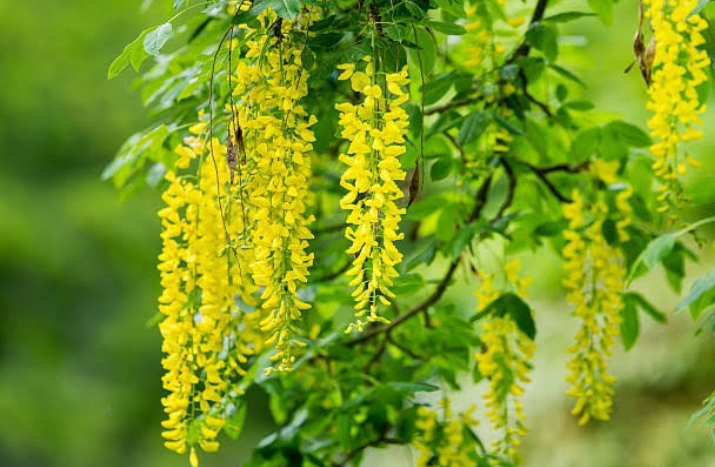
Golden Chain Tree is a large shrub or small tree in nature. It is native to southern Europe and western Asia but has been naturalized in other parts of the world, including North America. This indeed a beautiful shrub that can be used in a number of ways in yards and home gardens.
This shrub has compound leaves are bright green in the summer and turn yellow in the fall before dropping. Other than providing an attractive backdrop for the blooms. The leaves can contrast nicely with other plants such as roses and boxwoods.
The flowers of Golden Chain Tree are pea-like in shape, bright-yellow in color and have a spicy scent. They are held on the plant in pendulous clusters that can weigh down the branches. The flowers are produced in the late spring to early summer and can last for several weeks.
Golden Chain Tree can be trained to grow in an espalier, which is a technique that involves training a plant to grow flat against a wall or trellis. This can be a great way to save space in smaller landscapes or to create an interesting focal point. The shrub can also serve as an accent plant in areas such as near a garden bed or along a walkway.
Facts And Data
| Scientific Name | Laburnum anagyroides |
| Family | Pea family |
| Type | Deciduous |
| USDA Zone | 5-7 |
| Size | 6-15 feet |
| Native Area | Southern Europe and western Asia |
| Growth Rate | Slow |
| Form | Irregular |
Yellow Twig Dogwood
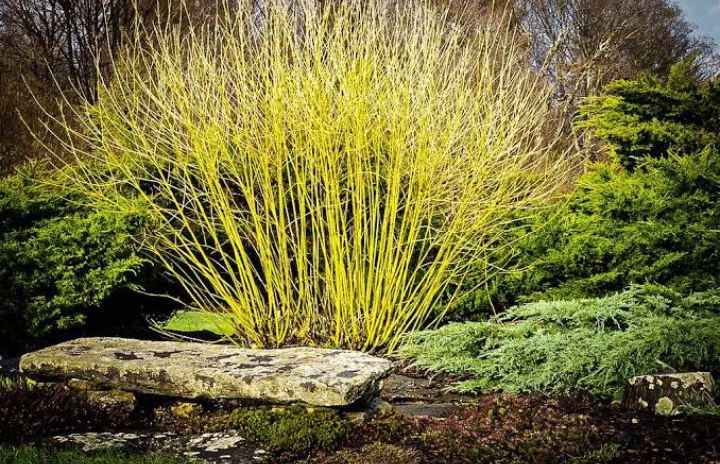
Yellow Twig Dogwood is also known as osier dogwood or yellow-stemmed dogwood. It grows up to 6 feet in height and 8 feet wide. It has a rounded, spreading growth habit, with multiple stems (whip-like canes) emerging from the base. It is cold hardy in U.S. Department of Agriculture zones 2 to 8.
The leaves of this shrub are oval in shape. They are bright green in color during the growing season, but turn a deep red in the fall. The leaves are not that appealing, but they just provide a backdrop for the shrub’s striking yellow twigs.
The stems of the Yellow Twig Dogwood are a bright and vibrant yellow color, hence the shrub’s common name. The stems are highly visible in the winter when the leaves have fallen off. Older stems tend to have a darker, more subdued yellow color.
In areas with full sun exposure, the stems may be a bright yellow color. In areas with partial shade, the stems may be more of a lime green color.
When planted in groups, Yellow Twig Dogwood’s vibrant twigs can provide the best contrast to a winter front house garden. It can also be grown together with other perennial plants in yards or used in container gardens.
Facts And Data
| Scientific Name | Cornus sericea ‘Flaviramea’ |
| Family | Dogwood |
| Type | Deciduous |
| USDA Zone | 2 to 8. |
| Size | 4-6 feet tall, 8 feet wide |
| Native Area | North America |
| Growth Rate | Slow |
| Form | Rounded |
Japanese kerria
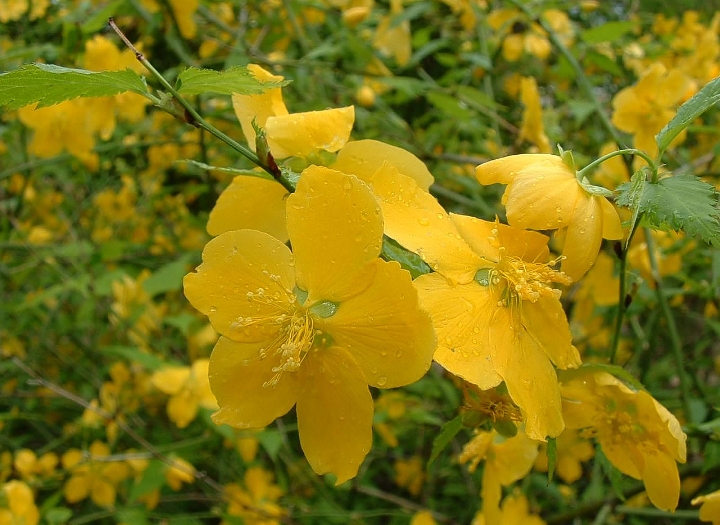
The Japanese kerria also known as Japanese rose, grows up to 6 feet tall and has arching stems that form a rounded shape. It is a good shrub for front yards and backyards or small gardens and container gardening.
Its leaves are dense and are dark green in color. During the fall season, the leaves of Japanese Kerria turn yellow before dropping off. Japanese Kerria produces yellow flowers that bloom in early to mid-spring, that is from April to May and they last for several weeks.
The flowers have a cup-like shape with a prominent center of stamens. The flowers can be single or semi-double, although there are some cultivars with fully double flowers. After the flowers fade, the shrub produces small, dry, brown fruit capsules that contain seeds.
Japanese Kerria can be planted in mixed borders with other shrubs, perennials and annuals. It pairs well with other spring-blooming shrubs like Forsythia, Lilac and Viburnum.
It can also be planted as a low hedge along a walkway or as a border around a garden bed. Given that it is a shade-tolerant shrub, it can also be planted in a woodland garden or along the edge of a wooded area.
Facts And Data
| Scientific Name | Kerria japonica |
| Family | Rose |
| Type | Deciduous |
| USDA Zone | 4 to 9. |
| Size | 4-6 feet tall, 6 feet wide |
| Native Area | China, Japan and Korea. |
| Growth Rate | Fast |
| Form | Rounded |
Mahonia
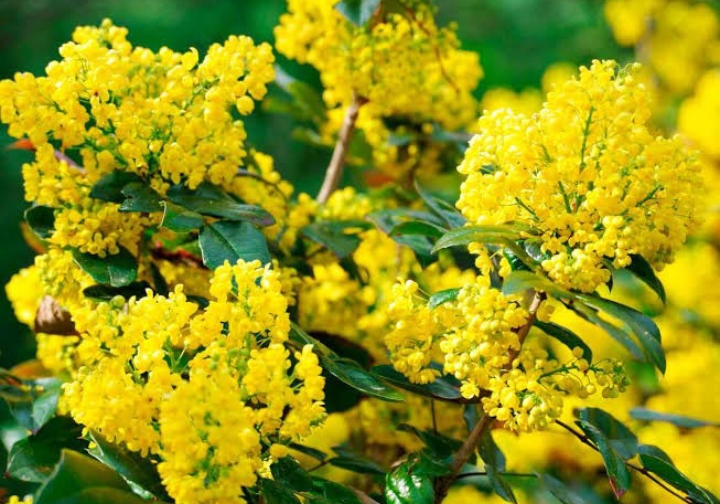
Mahonia is a genus of evergreen shrubs native to Asia and North America. There are many species of Mahonia, but the most commonly grown varieties include Mahonia japonica, Mahonia bealei, and Mahonia x media.
Mahonia shrubs grow up to 10 feet, but most often they stay under 10 feet in the yards. The shrubs have a bushy habit and produce multiple stems. The leaves of Mahonia vary in color from deep green to bluish-green, and can turn bronze or purple in the winter.
In late winter or early spring, Mahonia produces clusters of good smelling, yellow flowers. The flowers are arranged in racemes and can be either upright or drooping. The berries are blue or black and are often covered with a whitish bloom.
Mahonia can be used as a low-growing hedge or border plant in a front yard or you can grow it in a container and use it to provide year-round interest and beautify your patio.
Data And Facts
| Scientific Name | Mahonia ssp |
| Family | Barberry family, Berberidaceae |
| Type | Evergreen |
| USDA Zone | 5-9 |
| Size | 10 feet tall, 6 feet wide |
| Native Area | Eastern Asia, the Himalaya, North and Central America. |
| Growth Rate | Slow |
| Form | Rounded or Irregular |
Carolina Jessamine
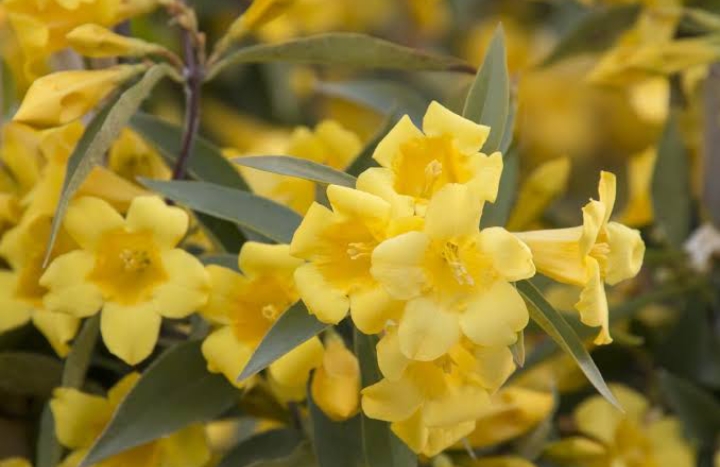
Carolina Jessamine is a twining evergreen vine or shrub that can grow up to 15 feet in length. It is very excellent plant that can be used to beautify your homestead garden. The plant can be trained as a low growing shrub or as a climbing plant on trellises, walls and fences.
Carolina Jessamine leaves are evergreen and plays a role in the plant’s ornamental value. The plant produces clusters of bright yellow flowers that are good smelling in nature. The flowers bloom in late winter or early spring.
The flowers of this plant are made up of five fused petals, which form a tube-like structure. The petals flare outwards towards the end of the tube, to form a trumpet-like shape.
The flowers are produced in clusters at the ends of the vine’s branches and can remain on the plant for several weeks. As the flowers age, they can turn slightly orange in color.
Carolina Jessamine can be planted along garden borders to create a natural edge or can be planted as a standalone specimen plant to create a focal point in the garden. Also given that it can climb wall, fences and trellises, you can use it as a vertical accent in the garden.
Facts And Data
| Scientific Name | Gelsemium sempervirens |
| Family | Family Gelsemiaceae. |
| Type | Evergreen |
| USDA Zone | 6-9 |
| Size | 15 feet wide and 20 feet tall. |
| Native Area | Southeastern region of the United States, including Florida, Georgia, Alabama, Mississippi, Louisiana, and Texas. |
| Growth Rate | Moderate |
| Form | Climbing |
Yellow azalea

Yellow azalea is a deciduous yellow flowering shrub that can also be cultivated as an ornamental plant in home gardens and public spaces. It is a medium-sized shrub that can grow between 10 and 13 feet tall.
This shrub has an upright growth habit with a dense branching structure. It also has attractive glossy green leaves that turn yellow in the autumn. The leaves are elliptical in shape, and are arranged in whorls around the stems.
The flowers are funnel-shaped and appear in clusters at the tips of the branches in late spring or early summer, usually in May or June. The flowers are a bright yellow color, although they can also range from pale yellow to deep golden-yellow. They have five petals that are somehow frilled at the edges. The flowers have a sweet, honey-like scent that is particularly strong on warm, sunny days.
Yellow azalea can be grown from seed, but it is more commonly propagated by softwood cuttings taken in early summer or by layering. It can also be grown from grafts or by division.
Yellow azalea can be used in front yard sand backyards in a number of ways. It can be planted along the foundation of a house or building. It can also be used as a border plant along walkways, driveways or property lines.
You can also plant it in groups or masses in the front yard particularly in front of evergreen shrubs or trees. You can also grow it in containers and place it on front porches, patios or other outdoor living spaces.
Facts And Data
| Scientific Name | Rhododendron luteum |
| Family | Heath family, Ericaceae. |
| Type | Deciduous |
| USDA Zone | 7-11 |
| Size | 10-13 feet |
| Native Area | Southeastern Europe and western Asia |
| Growth Rate | Slow |
| Form | Upright or irregular |
Yellow rose shrubs
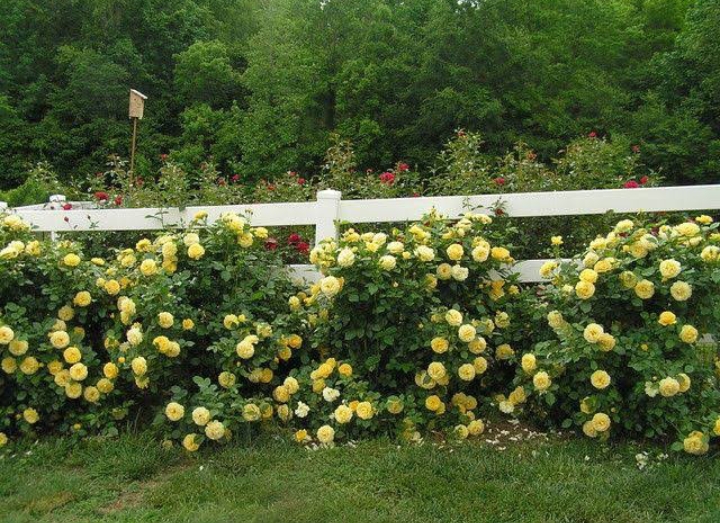
Yellow rose plants are a popular especially in North America as flowering shrubs because of their bright yellow blooms and scented nature. They are normally given as a gift for special occasions such as weddings or birthdays.
Yellow rose shrubs can range in height from 2 to 8 feet tall, with a spread of 2 to 5 feet wide. The leaves are dark green in color with a serrated edge. The leaves provide a beautiful backdrop for the bright blooms, and can add interest even when the roses are not in bloom.
Yellow rose shrubs can bloom at various times throughout the growing season. The color of the blooms can differ slightly from pale, creamy yellow to bold, sunny yellow. The blooms of this shrubs can take on different shapes from classic, fully double blooms to more open, single blooms.
Examples of yellow rose shrub varieties include: Graham Thomas, ‘Morden Sunrise, Sunsprite, Julia Child, Glowing Peace, Sunrise Sunset, Golden Showers, Gold Medal, Queen Elizabeth, and Golden Celebration.
Planted along a walkway or border or front yard, yellow rose shrubs can act as a focal point, drawing the eye to their bright and sunny blooms. Dwarf varieties of yellow roses are also ideal for growing in pots, allowing gardeners to enjoy their beauty on a balcony or patio.
Facts And Data
| Scientific Name | Rosa ssp |
| Family | Rose family |
| Type | Deciduous |
| USDA Zone | 3a through 9b. |
| Size | 3 to 10 feet tall. |
| Native Area | Middle East and Central Asia |
| Growth Rate | Fast |
| Form | Rounded or irregular |
The Austrian Briar
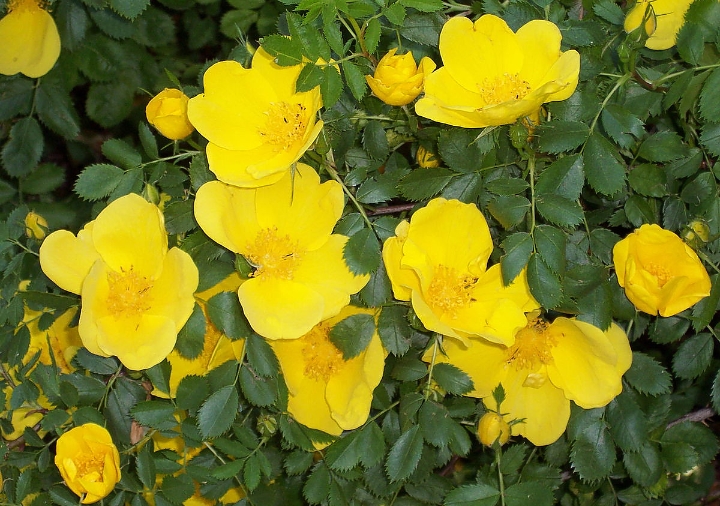
Rosa foetida, commonly known as the Austrian briar, can grow up to 10 feet tall and has an arching habit. It can just work fine to beautify home yards and public spaces. The shrub’s growth rate is fast, and it can reach its maximum size within a few years under favorable growing conditions.
The shrub has green leaves with serrated edges. The flowers of the Austrian Briar are bright yellow or dull-yellow and they bloom in the late spring or early summer. The flowers are large and have a musky scent that can be quite strong.
After the flowers have finished blooming, they give way to small red or orange fruits called hips.
The Austrian Briar is a hardy shrub and can tolerate different growing environments. It can also tolerate many soil types, though prefers well-draining soil. The plant can be propagated from seeds, cuttings or by layering.
This shrub can be used as a border plant in the front yards. It can also be used to line walkways and driveways by growing it with other shrubs and perennials.
Facts And Data
| Scientific Name | Rosa foetida |
| Family | Rose family |
| Type | Deciduous |
| USDA Zone | Zones 5, 6, 7 & 8 |
| Size | 3 to 6 feet tall. |
| Native Area | Europe, Asia and North America |
| Growth Rate | Fast |
| Form | Rounded or irregular |
The Yellow Elder
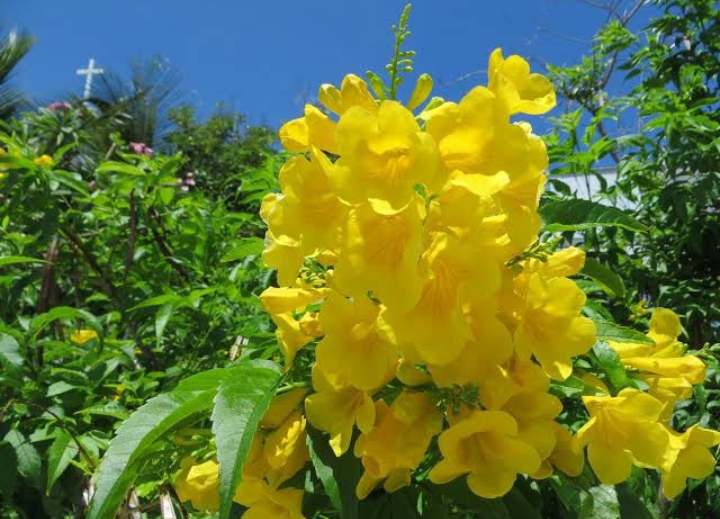
The Yellow Elder also known as Tecoma stans is a tropical shrub or small tree, also known as Trumpetflower, Yellow Bells, and Yellow Trumpetbush. The shrub is a prolific bloomer. It blooms almost year-round especially in warm climates. When provided with the right cultural environment, it can work in any forms of garden.
The shrub can grow up to 12 feet tall. It is a fast-growing, evergreen shrub that can be trained to grow as a small tree. The plant produces dark green leaves and yellow trumpet-shaped flowers that bloom in clusters at the end of the branches.
The Yellow Elder shrub is native to tropical and subtropical regions of the Americas, including the Caribbean, Central, and South America. It is well-suited to warm climates and can be grown in USDA hardiness zones 8-11.
The shrub is fast-growing and can be used for creating a living fence around the front yard or can be used as a specimen plant. It can also be planted in groups to create a mass of yellow blooms or in building a wildlife-friendly garden since its blooms are a magnet for bees, butterflies and hummingbirds.
Facts And Data
| Scientific Name | Tecoma stans |
| Family | Trumpet vine family |
| Type | Tropical Evergreen |
| USDA Zone | 8-11 |
| Size | 12 feet |
| Native Area | Americas [Caribbean, Central and South America] |
| Growth Rate | Fast |
| Form | Rounded or irregular |